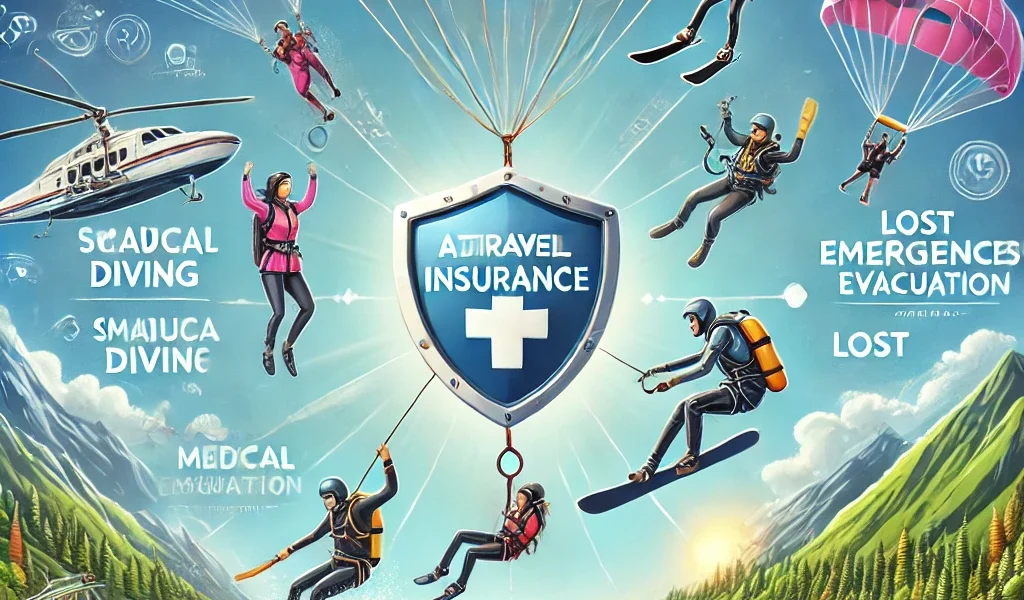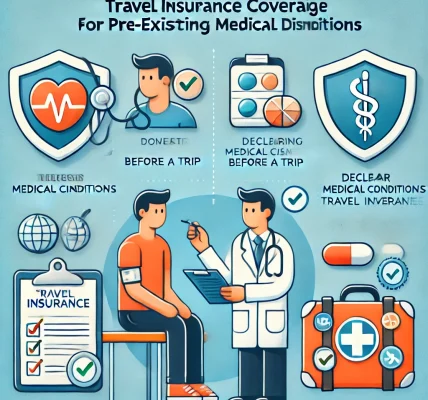Introduction
For thrill-seekers, adventure sports are an integral part of travel. Whether it’s skiing in the Alps, scuba diving in the Maldives, or bungee jumping in New Zealand, the excitement of high-adrenaline activities is unmatched. However, these sports come with inherent risks, making travel insurance with adventure sports coverage a necessity.
Not all travel insurance policies cover adventure sports. Many standard plans exclude high-risk activities, leaving travelers vulnerable to medical emergencies, injuries, and equipment damage costs. This guide will help you understand whether your travel insurance covers adventure sports, what to look for in a policy, and how to ensure you’re fully protected on your next adventure.
What Are Adventure Sports?
Adventure sports, also known as extreme or high-risk sports, involve physical challenges, speed, height, or specialized equipment. These activities can increase the likelihood of injuries, making proper insurance coverage essential.
Common Adventure Sports That May Require Extra Coverage
- Water Sports: Scuba diving, jet skiing, parasailing, surfing, white-water rafting
- Aerial Sports: Paragliding, bungee jumping, skydiving, hot air ballooning
- Winter Sports: Skiing, snowboarding, ice climbing, heli-skiing
- Mountain & Land Activities: Trekking, rock climbing, mountaineering, zip-lining, off-road biking
- Motorized Sports: Quad biking, dune bashing, motorcycling
- Competitive Sports: Marathons, triathlons, cycling races
Each insurance provider categorizes these sports differently. Some may be covered under standard policies, while others require an adventure sports add-on or a specialized insurance plan.
Does Your Travel Insurance Cover Adventure Sports?
Most basic travel insurance policies do not cover adventure sports due to the high risk involved. To check whether your policy provides coverage, review the policy wording, exclusions, and terms & conditions.
What Standard Travel Insurance Typically Covers
✔ Trip cancellations and interruptions
✔ Lost baggage and personal belongings
✔ Medical emergencies (excluding high-risk activities)
✔ Travel delays and missed flights
What Standard Travel Insurance Usually Excludes
✘ Injuries from adventure sports
✘ High-altitude activities (e.g., mountaineering above 3,000 meters)
✘ Scuba diving beyond a certain depth (e.g., 30 meters)
✘ Off-road biking, quad biking, or competitive racing
✘ Equipment loss or damage (e.g., skis, diving gear)
If you plan on engaging in adventure sports, you must purchase additional coverage to ensure protection against unexpected accidents or injuries.
How to Choose the Right Adventure Sports Travel Insurance
1. Check the Insurance Provider’s Definition of Adventure Sports
- Each insurer categorizes adventure sports differently. Some may cover skiing under a standard policy, while others classify it as an extreme sport requiring additional coverage.
2. Look for Comprehensive Medical Coverage
- Ensure the policy includes emergency medical expenses, evacuation, and hospitalization.
- Consider coverage for rescue services, such as helicopter evacuation in remote areas.
3. Confirm Coverage for Specific Activities
- If you plan to go scuba diving, ensure your policy covers dives beyond 30 meters.
- Skiers and snowboarders should check if off-piste skiing (skiing outside designated trails) is covered.
- Trekking enthusiasts should check altitude limits, as some policies only cover hikes below 3,000 meters.
4. Assess Equipment Coverage
- If you’re carrying expensive adventure gear, check if loss, damage, or theft is covered.
- Some policies offer add-ons for rented equipment.
5. Understand the Claim Process and Exclusions
- Read the terms carefully, especially exclusions related to alcohol consumption, reckless behavior, or failure to follow safety guidelines.
- Some policies require proof that you participated in the sport under a licensed operator.
Adventure Sports Insurance Add-Ons: Do You Need Them?
Many insurers offer specialized adventure sports add-ons that extend coverage to high-risk activities. Here are some popular ones:
1. Winter Sports Coverage
- Covers skiing, snowboarding, and avalanche-related injuries.
- Includes piste closure compensation (refunds if slopes are closed due to bad weather).
- Protects ski equipment from theft or damage.
2. Scuba Diving & Water Sports Coverage
- Covers injuries from diving, jet skiing, and wakeboarding.
- Includes emergency decompression treatment and hyperbaric chamber costs.
- Offers coverage for lost or damaged diving equipment.
3. Trekking & Mountaineering Coverage
- Covers high-altitude treks, mountaineering, and rock climbing.
- Provides emergency rescue, helicopter evacuation, and altitude sickness treatment.
- Some policies exclude trekking above 5,000 meters, so check altitude limits.
4. Adventure Racing & Motorized Sports Coverage
- Covers quad biking, dirt biking, and motorsport-related injuries.
- Provides third-party liability protection (important if you’re renting a vehicle for the sport).
- Some policies exclude racing or competitive events.
What to Do If You Get Injured While Participating in an Adventure Sport
- Seek Immediate Medical Attention – Visit the nearest hospital or medical facility.
- Notify Your Insurance Provider – Contact your insurer to initiate the claim process.
- Document Everything – Keep medical reports, receipts, and incident reports from activity operators.
- Follow Safety Guidelines – Ensure you were participating under safe conditions and within policy terms.
- Check Local Regulations – Some countries require additional insurance for adventure sports (e.g., Nepal for trekking permits).
Legal Considerations When Purchasing Adventure Sports Travel Insurance
- Disclose All Activities in Advance – Failing to mention high-risk activities can result in denied claims.
- Check Country-Specific Regulations – Some destinations mandate insurance for specific activities (e.g., Nepal for trekking, Austria for skiing).
- Verify Licensing Requirements – Some insurers require that you engage in adventure sports under a certified instructor or licensed operator.
- Understand Alcohol and Drug Policies – Injuries sustained while under the influence may not be covered.
- Confirm Coverage for Travel Companions – If you’re traveling with friends or family, ensure their participation in adventure sports is covered as well.
Conclusion: Is Adventure Sports Insurance Worth It?
Yes! If you’re engaging in any high-risk activity, purchasing adventure sports coverage ensures financial security, medical assistance, and peace of mind. Here’s a quick breakdown of who needs it:
✔ Casual Adventure Enthusiasts – Choose an add-on covering basic activities like skiing or snorkeling. ✔ Extreme Sports Lovers – Get specialized coverage for high-risk activities like skydiving or mountaineering. ✔ Frequent Adventure Travelers – Consider an annual multi-trip plan that includes adventure sports. ✔ Budget Travelers – Compare insurance providers to get affordable yet comprehensive coverage.




